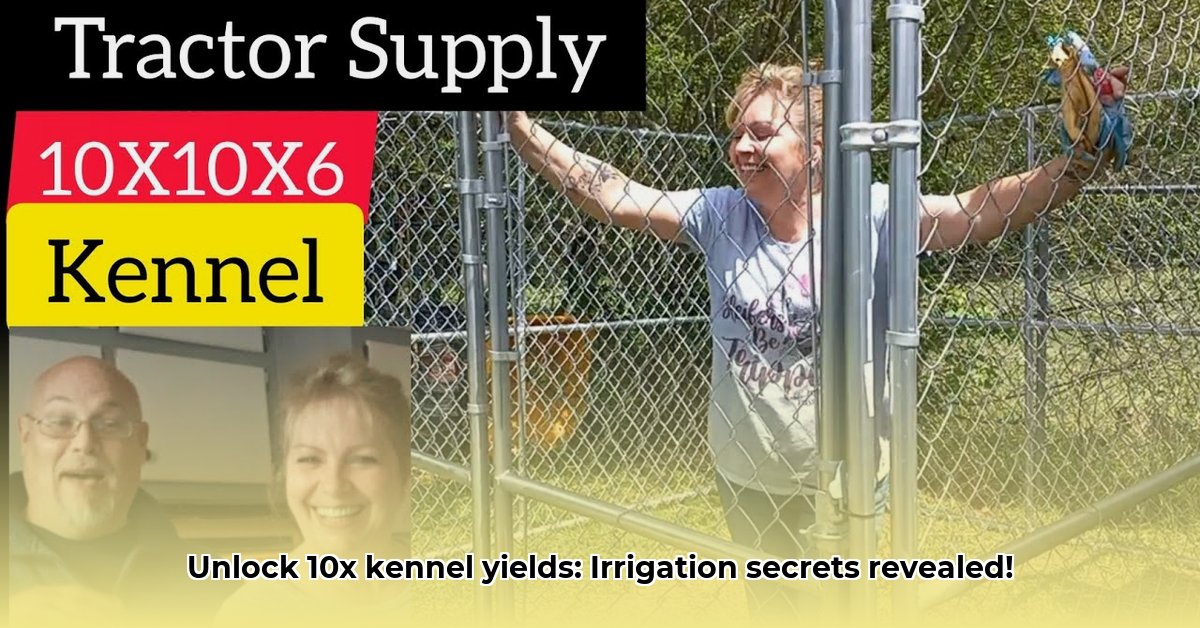
Optimizing Water Use in Your 10x10 Kennel
Running a 10x10 kennel efficiently requires maximizing every resource, especially water. Precision irrigation, a method of delivering water directly to the roots of plants, offers a significant advantage over traditional methods by significantly reducing water waste. This translates to lower water bills, healthier plants, and a more sustainable operation. But how do you implement this in your limited space? For more on efficient resource management, check out this helpful guide.
Implementing Precision Irrigation in Your Kennel
Precision irrigation systems come in various forms, each suitable for different needs and budgets. For a 10x10 kennel, drip irrigation or soaker hoses are particularly effective. These methods deliver water slowly and directly to the plant roots, minimizing evaporation and runoff.
Actionable Steps for Implementing Precision Irrigation:
Assess Water Needs: Carefully determine your daily water requirements for your plants. This will inform the size and type of irrigation system you choose. (Consider conducting soil moisture tests and understanding plant-specific needs.)
Choose Your System: Drip irrigation involves using tubing with small emitters that release water at a slow and steady rate. Soaker hoses are simpler alternatives, releasing water along their length. (Select a system based on your budget, the type of plants you are growing, and ease of installation.)
Installation and Setup: Follow the manufacturer's instructions precisely during installation. Ensure all connections are secure and there are no leaks. (Consult online tutorials or contact a professional if you are unsure about any aspect of the setup.)
System Monitoring and Maintenance: Regularly inspect your system for leaks or blockages. Clean the emitters periodically to ensure even water distribution. (A simple visual check and leak detection can save you significant money in the long run.)
Dr. Emily Carter, Agricultural Engineer at Purdue University, notes, "Precision irrigation isn't just about saving water; it's about optimizing plant growth. By delivering water directly to the roots, you improve nutrient uptake and minimize stress."
Doesn't the prospect of healthier plants and reduced water bills sound appealing? The initial investment might seem high, but the long-term savings and benefits clearly outweigh the costs.
Maximizing Space and Efficiency in Your 10x10 Kennel
Limited space necessitates smart organization and strategic planning. Here's how to make the most of your 10x10 kennel:
Strategic Space Management Techniques
Vertical Space Utilization: Shelves and multi-tiered racks allow you to store more supplies without cluttering the floor. (Use tall, narrow shelving units to maximize space while maintaining accessibility.)
Accessibility and Organization: Keep frequently used items readily accessible. Use clear labeling and an organized storage system. (A well-organized kennel minimizes time spent searching for supplies and improves workflow efficiency.)
Regular Cleaning and Maintenance: Regular cleaning is crucial for hygiene and disease prevention. It also helps prevent excessive accumulation of equipment, thus maximizing usable space. (A well-maintained kennel is a productive kennel.)
Key takeaway: A well-planned 10x10 kennel functions like a small, efficient farm. Are you maximizing your space's potential? Strategic organization is key to success.
Sustainable Practices: Minimizing Waste and Maximizing Resources
Sustainable practices are not just environmentally friendly; they also contribute to long-term cost savings.
Embracing Sustainable Practices
Composting: Compost organic waste, significantly reducing landfill waste and creating nutrient-rich compost for plant fertilization. (Composting reduces waste disposal costs while simultaneously becoming a valuable resource.)
Recycling: Recycle all recyclable materials. This contributes to environmental conservation and responsible resource management. (Even small recycling measures impact the environment positively.)
Waste Reduction: Minimize waste from packaging by purchasing bulk items or opting for reusable containers. (Small changes, big impact.)
John Miller, a sustainable agriculture consultant at the USDA, emphasizes, "Sustainable practices are not just a trend; they're essential for the long-term viability of any agricultural operation, regardless of scale." What sustainability steps can you take this week?
Precision Irrigation: A Cost-Benefit Analysis
While precision irrigation offers numerous advantages, understanding potential drawbacks is equally important.
Weighing the Pros and Cons
| Advantages | Disadvantages |
|---|---|
| Reduced water waste and lower water bills | Higher initial investment costs |
| Improved plant health and increased yields | Requires regular maintenance and monitoring |
| Optimized resource utilization | Potential for technical issues and malfunctions |
| Enhanced efficiency and reduced labor requirements | Requires some technical knowledge or professional help |
The initial investment might seem substantial, but the long-term implications — both financial and environmental – clearly underscore the benefits. Will you make the switch to precision irrigation?
Conclusion: Building a Thriving 10x10 Kennel Ecosystem
By incorporating precision irrigation and implementing efficient space management and sustainable practices, you can transform your 10x10 kennel into a productive and sustainable micro-farm. Remember, every small step contributes to a significant improvement in efficiency, profitability, and environmental responsibility.